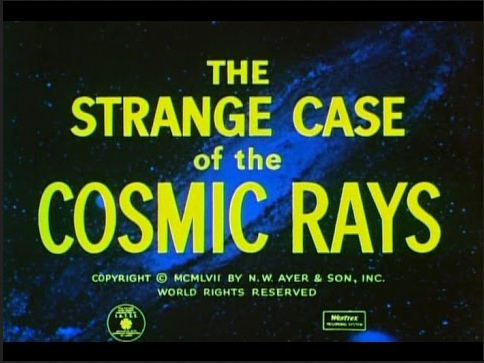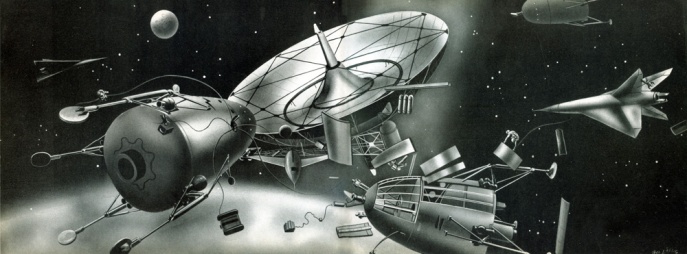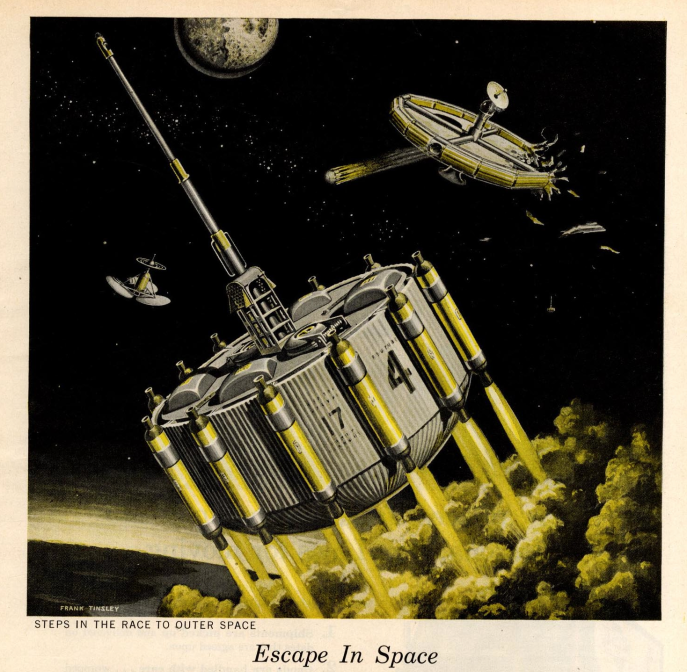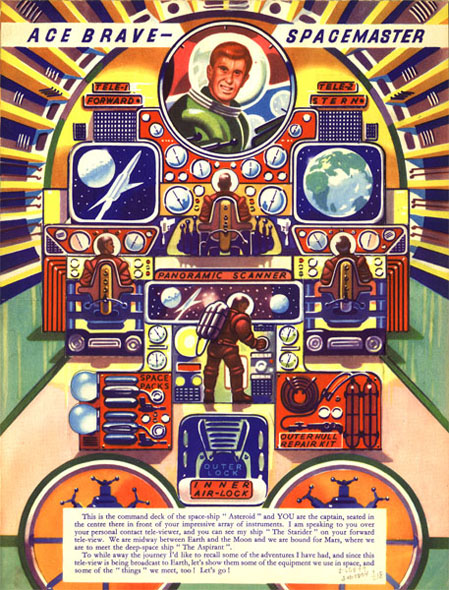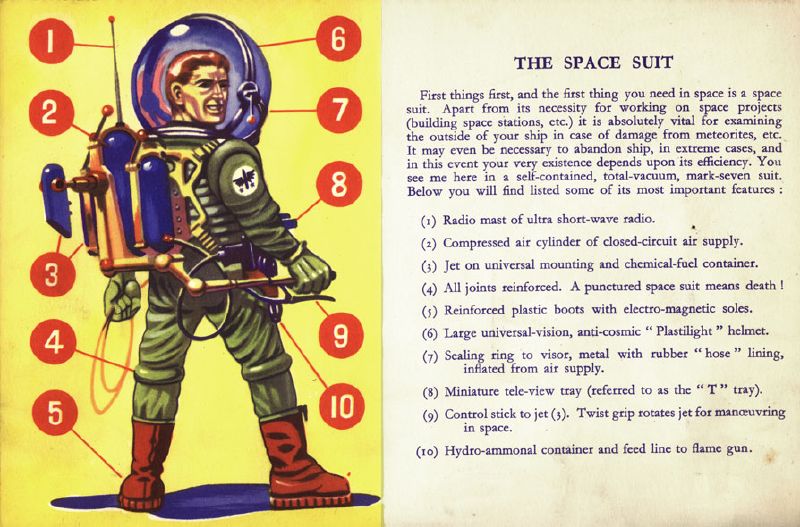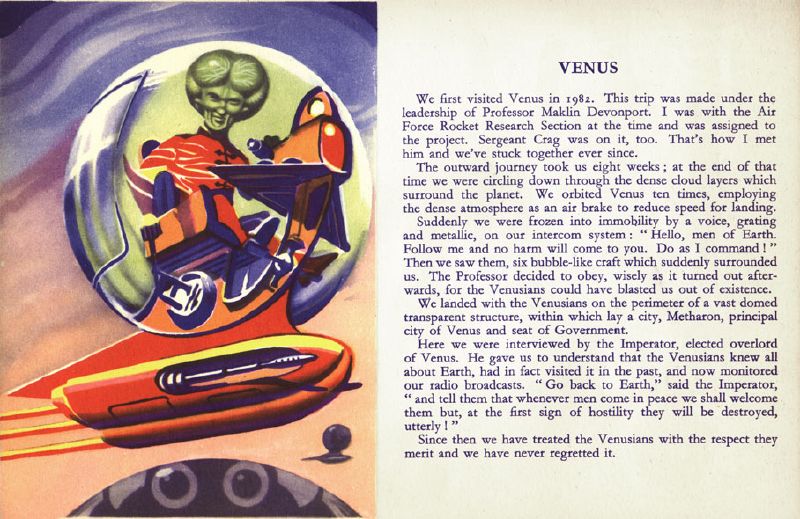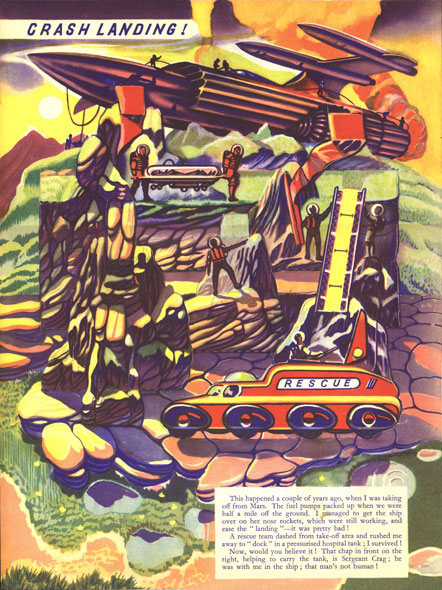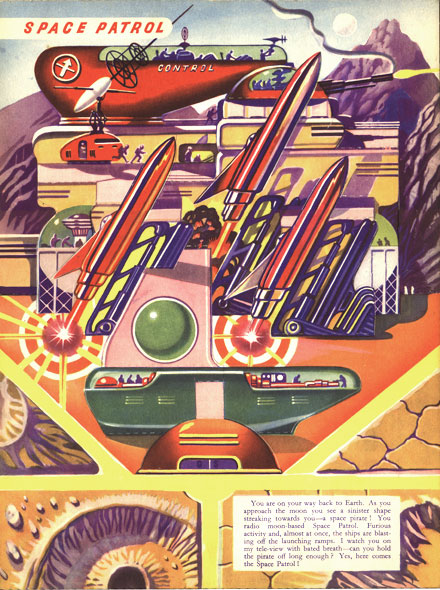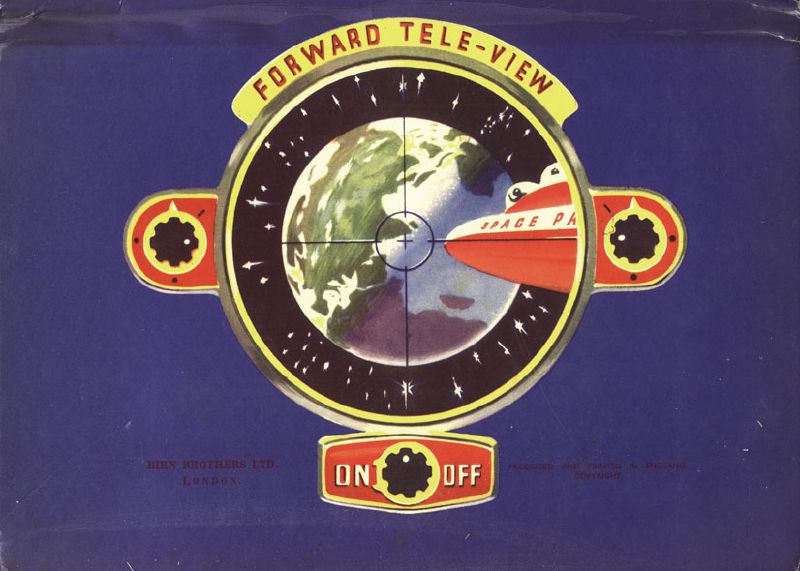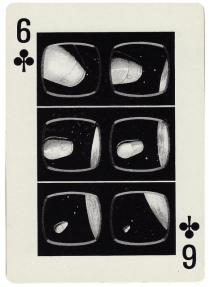The following article appeared in the March 1946 issue of Popular Mechanics magazine. It’s pretty fascinating. During that time, ‘cosmic rays’ were seen by a number of scientists as perhaps the most profound key to understanding the energy composed universe. Their enthusiasm regarding its properties and what it could mean for life on Earth shouts out in this article.
Today, modern scientists look at cosmic rays as more of a nuisance than anything else. The effects of raised levels of radiation exposure on high-altitude urban residents, as flight crews and passengers are something of a concern.
Wikipedia describes the problems of cosmic rays on modern electronic equipment:
Cosmic rays have sufficient energy to alter the states of circuit components in electronic integrated circuits, causing transient errors to occur (such as corrupted data in electronic memory devices or incorrect performance of CPUs) often referred to as “soft errors.” This has been a problem in electronics at extremely high-altitude, such as in satellites, but with transistors becoming smaller and smaller, this is becoming an increasing concern in ground-level electronics as well. Studies by IBM in the 1990s suggest that computers typically experience about one cosmic-ray-induced error per 256 megabytes of RAM per month. To alleviate this problem, the Intel Corporation has proposed a cosmic ray detector that could be integrated into future high-density microprocessors, allowing the processor to repeat the last command following a cosmic-ray event.
Without citing a source the Wikipedia article notes an ‘in-flight incident in 2008 where an Airbus A330 airliner of Qantas twice plunged hundreds of feet after an unexplained malfunction in its flight control system’, and suggests that ‘cosmic rays were suspected as a possible cause…’
The effects of cosmic rays are seen as a significant barrier to interplanetary travel for manned spacecraft, as well as the onboard electronics. Cosmic rays have been suggested as having been responsible for major climatic change and mass-extinction in the past. One physicist, Henrik Svensmark, has recently argued that cosmic ray flux can even be an indirect cause of global warming – the arguments sparking controversy regarding his methods. etc..
One can’t help but wonder – with all the positive aspects to cosmic ray research cited below, and all the negative impacts cited in today’s world of technology and environment, could science and the world of modern technology taken a wrong route? Had developers pursued research more in line with ingenious Nikola Tesla’s work in ‘free energy’ technology, rather than his detractors like Thomas Edison, would the current conflicts with cosmic rays already have had resolutions? If orthodox physics gave a more serious bit of attention to today’s ‘Electric Universe’ theorists, would we come closer to understanding and unlocking the mysteries of the universe?
One wonders…
An added bonus: included at the end of the article is the 1957 film short, The Strange Case of the Cosmic Rays – an episode from The Bell System Science Series produced by the AT&T Corporation.
The Strange Case of the Cosmic Rays is an examination of what cosmic rays are and how they work. It was written by Capra with Jonathan Latimer, a crime fiction novelist and screenwriter. As Gilbert describes it, the third and fourth films “repeated the formulas of his earlier work while ever searching for new contrivances for popularization as well as the best language to express his soft religious message” and that the script was essentially a reworking of ideas Capra had developed for a possible documentary about Robert A. Millikan. The film’s screenplay works from the premise that the nature of cosmic rays is a mystery comparable to the great detective stories. A committee of marionettes representing Fyodor Dostoevsky, Charles Dickens, and Edgar Allan Poe is called upon to decide the question. The film was broadcast on October 25, 1957, apparently with a smaller television audience share and with more unfavorable reviews than for the first two specials.

Popular Mechanics March 1946 – University of Chicago athletic field is launching site for balloons which will lift cosmic my equipment into the stratosphere.
YOU IMAGINE a ray so powerful that it will penetrate a solid mass of lead as high as a four-story building, or as thick as live sixths of the distance between the pitcher’s box and home plate? The cosmic ray does exactly that — and even more, it gives promise of unlocking several of the major secrets of the universe.
Coming apparently out of the nowhere– possibly from the Milky Way, maybe from interstellar space beyond this universe — Cosmic rays beat down upon us, day and night, like rain. In fact. 20 rays pass through your body -head to foot if you are standing — every second. Whether one climbs to the top of the highest mountain, hides away in the deepest mine, or plows the surface of the sea as a typhoon rages, the incomparably powerful cosmic rays reach him. Radium rays, X-rays — even atomic rays — bow to the gargantuan might of this king of all radiations.

Dr. Marcel Schein (center) inspects apparatus which makes photographic record of cosmic rays in sky
For more than two decades many of the world’s greatest scientists have kept relentlessly on the trail of the cosmic ray. Expeditions have ascended great peaks, invaded deserts, ridden ocean liners for months at a time, ascended into the stratosphere by planes and balloons and sent delicate registering instruments higher into the sky than man has ever flown — all to fathom the mystery of the giant of rays.
In their quest to solve it. scientists have taken cosmic ray “soundings” in the Paris catacombs, in gigantic glacier cracks, in the fjords of Norway and inside the barrels of cannon big enough to hold the equipment and the researchers alike. They have gone down into brine pits to test the ray under crystallized salts of the sea; they have invaded mines where iron, coal or copper are dug and they have dived deep into the sea for underwater registration of the rays.
They improvised watertight diving bells, complete with cosmic ray equipment from storage batteries to photographic apparatus and automatic registering instruments, which they sank from a quarter to a half mile deep, letting them lie there for days at a time. They built specially designed “cloud chambers” for high altitude studies. They improvised special instruments for registering the rays in the crevasses of glaciers.
The present stage is still that of the hunt. Until more is known about the cosmic ray, little can be done to harness it. To date, rays are controlled to the point of being heard over loudspeakers, operating delicate automatic photo equipment and lighting up indicator lamps. But the world’s best minds say that its secrets will be revetted, and then it may be mastered for the use of man. Scientists, with their usual caution, do not speculate on its practical possibilities. But they do admit that they are illimitable.

Cosmic rays raining dawn upon the earth penetrate everything with energy measured in billions of volts
Those possibilities are as intriguing a subject as ever comes to the mind of man. Unlimited power is the key— not only that, but unlimited power already created and ready for use. We think of atomic energy, but realise mammoth machinery will be necessary to produce it — at present, an atomic energy driven auto would weigh at least 100 tons! But cosmic power may some day be pulled out of the air by a receiver, exactly as we pluck radio waves out of the air with our sets. In that near or distant day, put a cosmic aerial on your house or your auto, and presto! Power flows in like a Niagara.
To those who puzzle over the composition of the universe, its age, and whether the universe is building up, self-sustaining, or running down, the cosmic ray holds fascinating potentialities. About unlocking the history of the universe, none other than Dr. Arthur H. Compton, one of the world’s greatest physicists, Nobel prize winner for his research on the cosmic ray, and now chancellor of Washington University, St. Louis, had this to say:
“Very possibly cosmic rays are older than the earth itself, for their energies are so high that calculation shows that if a particle {cosmic ray) is once thrust out into space, it can continue, before it is stopped by the matter in interstellar space, for a time equal at least to the estimated age of the earth. Thus, there is reason to hope that future study of these rays may bring us valuable information regarding the ancient history of the universe.”

Dr. Arthur H. Compton adjusts cosmic my counter before balloon test. Right, vertical streak is path of cosmic ray photographed in “cloud chamber.” It has struck an electron (center) and knocked it out of orbit
Some physicists estimate the rays as 10 billion times stronger than radium rays; the most penetrating variety enter outer space with the energy of 15 billion volts.
Not only does the cosmic ray possibly contain the key to terrestrial antiquity, but it also may hold the solution to that even more fascinating proposition: What of the future of the universe? One theory projected by scientists is that the cosmic ray is produced in the building up of atoms, thus indicating that the universe Is perpetually renewing itself. Other eminent men hold to the opposite belief; namely, that the cosmic ray is produced in the destruction of atoms and that the universe is running down. Many affirm that cosmic rays are the basic form of energy.
The romance of the cosmic ray at the present stage is not in actual achievement with it, but in the indefatigable and ingenious research for it. Twenty years ago, Dr. Robert A. Millikan, Nobel prize winner, professor of physics at the California Institute of Technology and pioneer in cosmic ray study, declared, after he had conducted research in the Andes mountains, that “we cannot even begin to assert what change in man’s view of the universe this ray will bring about.”

The rays, which have been ranging the cosmos for possibly a billion years or more, first caught the attention of man about 1900, when it was found that nonelectrical gases, perfectly insulated, continued to act like electric current conductors. Scientists tightened up all possible leakages of electricity and radiations but found themselves against a blank wall of mystery.
Two scientists. Lord Rutherford and H. L. Cook, at McGill University in Montreal, buried an electroscope in five tons of lead, a metal then accepted as a substance through which no rays or radiations known to man could penetrate. Yet the delicate instrument continued to register a mysterious electrical action. They could discover no earthly connection. But they, and many others, refused to yield to what seemed inscrutable — their restless minds would not be conquered. In different lands, scientific pioneers kept on the elusive trail. They began to suspect dimly that something beyond terrestrial origin was causing the “trouble.” Spasmodically the search continued. In 1910 a notable contribution was made by a Swiss scientist, Dr. Gockel, who reached unparalleled altitudes in a balloon. His studies tended to show the rays came from somewhere out in space, A year later, V. F, Hess, an Austrian scientist who won the Nobel prize for his research, wrote of his investigations:
“During the past two years I have made seven balloon ascensions, I find no decrease in the intensity of the penetrating radiations at higher altitudes. In fact, there is a truly significant increase. Since, at great heights, any contribution of rays from the earth should have decreased, I have concluded that these radiations almost certainly come from beyond the atmosphere itself.”
The cosmic ray hunt was interrupted for virtually a decade by World War I, but the delay seemed to have added impetus once the search was renewed. Scientists the world over, fascinated and challenged by this Mystery Visitor No, 1 to our universe, got on the trail with the vim of crusaders.
As early as 1922 Dr, Millikan made cosmic ray measurements 50,000 feet high in the stratosphere by suspending instruments from a 15-foot cord strung between two balloons. The instruments included electroscope, barometer and thermometer. The experiment was repeated and material results were attained in determining the energy of the cosmic rays falling upon the earth. Dr. Millikan also took soundings deep in a lake, where the resistance to the rays was the equivalent of 25 feet of lead.
Within a decade, research was going on in various parts of the earth, but the most intense center of all was the University of Chicago, where Dr, Compton directed a “world survey of cosmic rays.” Preparation of this stupendous project was as orderly as the preparation of a nation for war. Largo expeditions were outfitted, the best available scientific minds were enlisted and strategy was developed on a global scale, The climax of action was reached between 1931 and 1934 when 12 expeditions from the great Chicago institution scattered to their observation points. In their travels, the crews covered 250,000 miles.
One went to South Africa, another to Peru, a third to Alaska, a fourth to Australia, and so on. They visited the tropic and arctic regions alike. The earth was used as a gigantic magnet and the mountain peaks as laboratories. Cosmic radiations were measured at high altitudes and compared with those on the surface of the earth and deep in mines.
Compton’s experiments were conducted on the principle that lines of magnetic force are passing constantly around the earth between the north and south magnetic poles. These lines of force deflect the needle of a compass and all substances electrically charged, but they do not affect substances that are electrically neutral. Compton’s expeditions found that cosmic rays were much denser in the Arctic Circle than near the equator. At the time this seemed to indicate that cosmic rays are deflected toward the magnetic poles of the earth and are therefore electric ally charged.
Cosmic ray research reached a high spot in spectacularity during the Century of Progress Exposition in Chicago in 1933-34. Airplane and balloon flights were sponsored by the Chicago Daily News, the National Broadcasting Company and the Exposition. One of them was made by Professor Auguste Piccard, the famous French pioneer of the stratosphere* who attained a height of 15 1/2 miles.
In 1934 a mammoth instrument, called “a new sentinel for cosmic rays,” was designed by Dr, Compton, and seven of them, labeled “scientific outposts,” were set up at far corners of the earth. One, operated by the Massachusetts Institute of Technology, was carted to the top of Mt. Evans, more than 14,000 feet high. The instrument weighed a ton and a half, and the idea was to conduct cosmic ray tests not only at high altitudes but also under violent weather changes. Studies were made where the temperature often dropped from a balmy fit) above zero to below freezing in five minutes, and where also, with equal brevity, summer sunshine would shift to a blinding blizzard. The meters were designed to operate for a long period, under the most severe conditions, each having an automatic photographic recording device and equipment to compensate for temperature and atmospheric pressure changes. As we said of them at the time:
“They will record the tides in the ceaseless rain of invisible rays which penetrate their thick lead shields and produce a flash of light in the argon-filled chamber. They will show the direction of the rays over a long period of time and any rise or fall in their numbers. They will record changes, if any, of the rays with the time movements of the stars, with fluctuations of the earth’s magnetic field and the frequency of sunspots.”
Other ray meters were distributed from Peru to Greenland.
Thus the hunters followed the trail with relentless zeal. Danger meant nothing to them. An entire Russian group of scientists and helpers plunged to their death in a balloon crash, while a similar American outfit had to take to their parachutes. A noted scientist, Dr. Allen Carpe, and his assistant, who scaled Mt. McKinley and made observations, were killed while making explorations of a huge Alaskan glacier. Cosmic ray observations were made in airplanes soaring 30,000 feet over huge volcanoes in the southern Andes. A specially built electromagnet weighing more than eight tons was brought into use to observe the deflection of rays passing through a magnetic field. Observations were taken regularly at 40 widely separated stations — one of them a copper mine near Mohawk, Michigan, where rays were found to have penetrated 1600 feet of rock.
One of the most ambitious experiments in cosmic ray research was staged shortly before World War II, when a 21-passenger airliner was used in Chicago to take soundings. The plane reached a height of 26.000 feet, flying 450 miles in three hours with the temperature below zero. At that height, Dr, Marcel Schein and Dr. Volney C. Wilson, of the University of Chicago, kept constant watch over the ray meter, which was composed of copper tubes and excluded all but cosmic rays. They observed that the more penetrating cosmic rays beat down 10 times faster at that elevation than at the earth’s surface. It also was found that a recently discovered particle— the mesotron — was created by the action of neutral rays in the lead filter placed above the counters.

Altitude and Density Chart
For three years before the war, cosmic ray observations were conducted on a ship running regularly between Vancouver, B, G., and New Zealand. The effort was to discover whether the rays originate in our universe or outside. A year later an other cosmic ray research plane reached an elevation of 29,000 feet with photographic equipment that effectively used the “cloud chamber,” an apparatus which includes a glass-walled chamber in which is produced an artificial cloud. As the cosmic ray shoots through the air, it breaks the molecules into ions. In the artificial cloud, the ions form drops of moisture and these mark the track of the rays. The track is photographed by the aid of bright lights.
Cosmic rays from the direction of a “star cloud,” estimated to be 5000 light-years away, were employed to turn on a cluster of fluorescent lights at the Hayden Planetarium, New York, on June 17, 1941, which in turn, illuminated a ‘Letter to the future” to be opened 5000 years hence.
Much research has been done through the years by means of “free” balloons which are sent aloft with delicate registering apparatus in cosmic ray research. Many of the balloon experiments were conducted by Dr, Compton and Dr. W. P. Jesse of the University of Chicago, Two years ago cosmic ray equipment supported by 29 balloons was sent up from Chicago and came down 40 miles from Columbus, Ohio. The device consisted of a 30 -foot pole with two sets of three cosmic ray counters and batteries designed to register cosmic ray showers. Dr. Schein reported that cosmic ray showers were discovered at heights of more than 50,000 feet.
Six months later, another “free” balloon ascension was made, the equipment coming down in Virginia after a 500-mile record-breaking Right. A little more than a year ago University of Chicago physicists launched 36 balloons bearing a 60-pound cosmic ray photographic apparatus. The “free” balloons have carried automatic cosmic ray apparatus more than 17 miles in the air on different occasions, or upwards of 90,D00 feet! The balloons, inflated with hydrogen, are made of extraordinarily elastic material, so that while they measure only five feet in diameter at the start of the ascent, they inflate to 20 feet in diameter when 16 miles or more in the air. Sometimes when a cluster of the balloons descends people take them for paratroopers. A note offering a reward for return of the equipment to the sender is attached to each unit, and nine times out of 10 the records and material are returned. Free balloon flights have registered up to 100 miles an hour in cross-country flight. They ascend at the rate of 700 to 1000 feet a minute. One of the strangest happenings was when a cluster was sent up from the University of Chicago, traveled several hundred recorded miles, and returned like a boomerang to a point within five miles of the campus!
Another device is a short-wave radio system that sends the impulses to scientists on the ground, dispensing with the need for a him record. Still another unique experiment was conducted late last fall when 49 balloons were released from Stagg Field at the University of Chicago. This experiment was in charge of Dr. Schein of the university, Along with 70 pounds of cosmic ray apparatus were sent 200 flour beetles to determine the effect of cosmic rays on insect life. This experiment was thwarted by the accidental death of the beetles through escaping gases, but the effort will be repeated as the objective is considered of paramount importance.
Other studies show that gamma rays found in cosmic radiation are the shortest known. X-rays are too short to be visible, and gamma rays in radioactive materials are from 10 to 100 times as short as X-rays. However, the shortest known gamma rays of cosmic radiation are 100 million times shorter than the gamma rays of radioactive bodies. Research shows there are various kinds of cosmic rays, particularly the “soft” (electrons and gamma rays) and the “hard” (mesotrons), The former are easy to absorb, but the hard rays of high energy are the ones that penetrate anything. They are millions of times stronger than any other known radiation and shoot like irresistible bullets through every known thing.
Another dramatic discovery is the fact that there are frequent cosmic ray “showers,” the particles falling like heavy rain over an area equal to two or three acres. As many as a million rays are contained in a single shower and 50 or 60 showers fall in a single hour. They are called “Auger showers” in honor of the famous French scientist, Pierre Auger, whose research in the Alps mountains brought the new discovery to light. You can listen in, through an ingenious loudspeaker device, on a cosmic ray shower, and it sounds something like a summer storm. It is a roaring sound, like rain driven by wind, then sudden quiet for a moment, followed by another squall.

Comparative Wavelengths
While we are struck constantly by both the continuous downpour of cosmic rays and the occasional heavy blast of a shower, they do not register any known effects on us. People living at high altitudes get a double dose, while men working deep in mines receive only a fraction of the rays, but neither seem in the least affected.
The latest scientific effort is mostly in the field of relating the cosmic rays to atomic radiations. Nearly 15 years ago one scientist predicted that cosmic ray study would throw light on the problem of how the core of the atom is built, and thus open the way for the release of atomic energy for human uses. As far as it can be gathered from guarded statements by scientists, it is likely that the cosmic lay is the key to the release of atomic energy and to the analysis of the atomic ray. In fact, it is reported that the cosmic ray is held to be the means of unlocking the secret of X-ray and radium as well. Further than that, a professor, John Archibald Wheeler of Princeton University, holds that by studying cosmic rays man eventually may discover means of transforming any kind of matter, not uranium alone, into atomic energy.
A new giant, called the betatron, invented by 34-year-old Donald W. Kerst, a University of Illinois professor, is soon to come into the field of cosmic ray research. The instrument uses electric magnetic energy to speed the flight of electrons up to 185,000 miles a second, virtually the same as that of light. It is expected to reproduce cosmic rays for close study, possibly eliminating the need for scientists to fly into the stratosphere or burrow into mines.
How long must the relentless search move on before the cosmic ray finally is brought into captivity and lamed? No one knows. Most scientists say that, if human cussedness in the form of war will lie dormant long enough to let science carry on its hunt uninterruptedly, 10 to 20 years ought to be enough to make us master of the supreme source of unlimited power.
